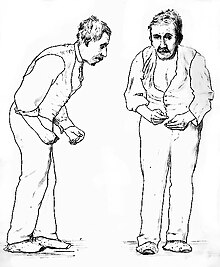Parkinsonism
| Parkinsonism | |
|---|---|
 | |
| Specialty | Neurology |
| Causes |
|
Parkinsonism is a clinical
Signs and symptoms
Parkinsonism is a clinical
Parkinsonism gait problems can lead to falls and serious physical injuries. Other common symptoms include:
- Tremors, as rest tremor (when resting, mostly in the hands) and/or postular tremor
- Short, shuffling gait
- Slow movements (bradykinesia)
- Loss of sound perception leading to soft speech, hypophonia[5]
- Difficulty sleeping
- Dry skin
- Apathy
- Lack of facial expressions
- Balance problems
- Frequent falls
- Very small handwriting
- Rigid, stiff muscles
- Cogwheeling(jerky feeling in arm or leg)
- Upgaze impairment
- Plastic, dead feeling resistance known as "lead-pipe rigidity".[3]
Conditions
Parkinsonism occurs in many conditions.
Neurological
- Corticobasal degeneration[6]
- Dementia with Lewy bodies[6]
- The relationship (if any) with essential tremor is not clear.[7]
- Pick's disease)[8]
- Gerstmann–Sträussler–Scheinker syndrome[6]
- Huntington's disease[6]
- Lytico-bodig disease (ALS complex of Guam)[6]
- Shy–Drager syndrome)[6]
- Neuroacanthocytosis[6]
- Neuronal ceroid lipofuscinosis[6]
- Olivopontocerebellar atrophy[6]
- Pantothenate kinase-associated neurodegeneration, also known as neurodegeneration with brain iron accumulation[6]
- hereditary juvenile dystonia[6]
- Parkinson's disease[6]
- Parkinson's disease dementia[9]
- Progressive supranuclear palsy[6]
- Wilson's disease[6]
- Lubag syndrome)[6]
Infectious
Toxins
Evidence exists to show a link between exposure to
Chronic
Agent Orange may be a cause of parkinsonism, although evidence is inconclusive and further research is needed.[16]
Other toxins that have been associated with parkinsonism are:
- Annonaceae[17]
- Carbon monoxide[6]
- Carbon disulfide[6]
- Cyanide[6]
- Ethanol[6]
- Hexane[18]
- Mercury[6]
- Methanol[6]
- MPTP[6][19]
- Rotenone[20]
- inhalant abuse: "huffing")[22]
Vascular
- Binswanger's disease (subcortical leukoencephalopathy)[6]
- Vascular dementia (multi-infarct)[6]
- Dural arteriovenous fistula / dAVF (reversible parkinsonism through fistula treatment) [23][24][25]
- Dural arteriovenous malformation / dAVM (reversible through dAVM treatment) [26][27]
Other
- Chronic traumatic encephalopathy (boxer's dementia or pugilistic encephalopathy)[6]
- Damage to the brain stem (especially dopaminergic nuclei of the substantia nigra),[28]basal ganglia (especially globus pallidus)[29] and the thalamus.[30]
- Hypothyroidism[6]
- Orthostatic tremor[31]
- Paraneoplastic syndrome: neurological symptoms caused by antibodies associated with cancers[32]
- Rapid onset dystonia parkinsonism[33]
- Autosomal recessive juvenile parkinsonism[34]
Differential diagnosis
Secondary parkinsonism, including vascular parkinsonism and drug-induced parkinsonism.[35][36]
Drug-induced ("pseudoparkinsonism")
About 7% of people with parkinsonism developed symptoms as a result of side effects of medications, mainly neuroleptic
Implicated medications include:
- Antipsychotics[6]
- Lithium[6]
- Metoclopramide[39]
- MDMA (addiction and frequent use)[40][41]
- Tetrabenazine[6]
- Cinnarizine[37]
Society and culture
In the United States, the 2021 National Defense Authorization Act (NDAA) added parkinsonism to the list of presumptive conditions associated with Agent Orange exposure, enabling affected service members to receive Veterans Affairs disability benefits.[42]
References
- ^ ISBN 978-0-07-142360-1.
- ^ PMID 30275744.
Parkinsonian syndromes are a group of movement disorders characterized by classical motor symptoms such as tremors, bradykinesia, and rigidity. They are most frequently due to primary neurodegenerative disease, resulting in the loss of dopaminergic nerve terminals along the nigrostriatal pathway, similar to idiopathic PD, MSA, PSP, CBD, and DLB.
- ^ ISBN 978-1-260-12241-1. Retrieved 1 April 2024.
- PMID 15380498.
- PMID 21961077.
- ^ ISBN 978-99976-25-88-5.
- PMID 28729090.
- PMID 27042904.
- PMID 28592453.
- PMID 16364674.
- PMID 15261874.
- S2CID 13628268.
- ^ PMID 26220508.
- ^ PMID 26154659.
- PMID 27814772.
- S2CID 222299758.
- PMID 12717675.
- PMID 21258587.
- PMID 15614202.
- PMID 27598189.
- ^ Weiss J. Chapter 151. Toluene and Xylene. In: Olson KR, ed. Poisoning & Drug Overdose. 6th ed. New York: McGraw-Hill; 2012. http://www.accessmedicine.com/content.aspx?aID=55982958. Accessed April 21, 2013.
- S2CID 23657208.
- PMID 30363443.
- S2CID 31594108.
- PMID 26413242.
- S2CID 22701874.
- S2CID 246556634.
- PMID 20011063.
- PMID 15774432.
- PMID 20082979.
- S2CID 36301428.
- PMID 21577108.
- PMID 27835968.
- S2CID 22733500.
- PMID 36979299.
- PMID 35589315.
- ^ S2CID 31516105.
- ^ "Information Sheet: Drug-induced Parkinsonism" (PDF). Parkinson's Disease and Society. Archived from the original (PDF) on 2013-06-26. Retrieved 2013-04-15.
- PMID 26660063.
- PMID 24033795.
- ^ Fabrizi, Monaco, Dalla Libera (2004). "Parkinsonian syndrome following MDMA (Ecstasy) addiction". Movement Disorders. 19: S73–S74.
{{cite journal}}: CS1 maint: multiple names: authors list (link) - ^ "VA adds three new Agent Orange presumptions". U. S. Department of Veteran Affairs. September 10, 2021. Retrieved March 2, 2022.
